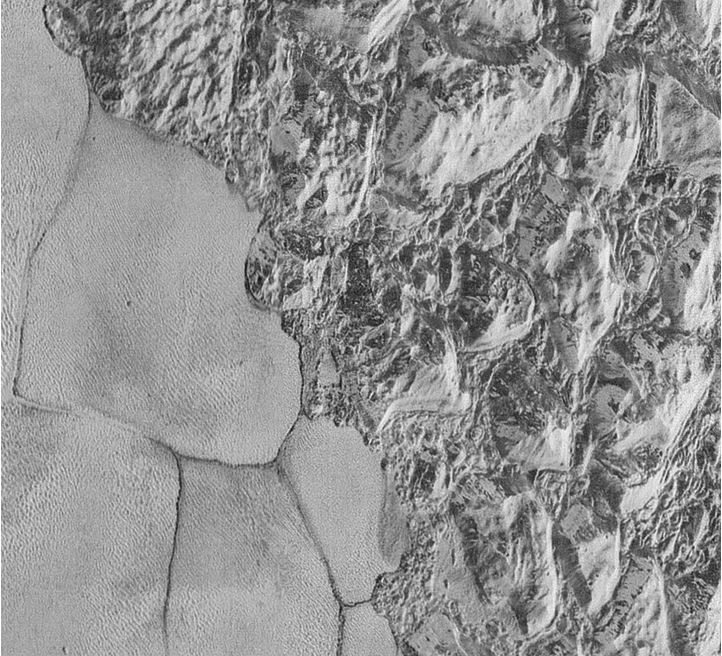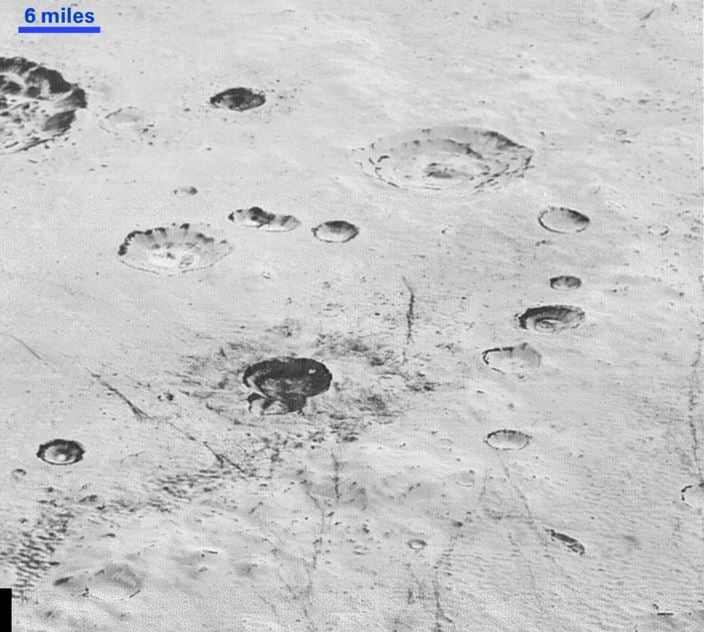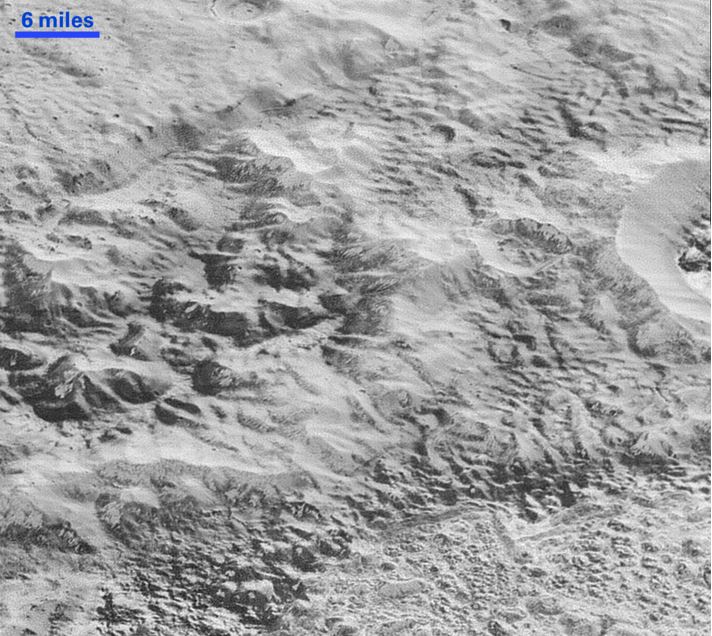Some breathtaking images of Pluto taken by New Horizons during its July flyby have been published by NASA, which describes the surface as ‘a frozen wonderland’. They are the sharpest views ever of the dwarf planet located in the Kuiper belt, three billion miles from Earth. The American space agency added that they are the best close-ups of Pluto that we may see for several decades.
Every week, New Horizons, an interplanetary space probe that was launched in January 2006 as part of NASA’s New Frontiers program to study Pluto, transmits data stored in its digital recorders from its voyage through the Pluto system on July 14th, 2015.
The pictures published on December 4th are part of a sequence taken near the probe’s closest approach to Pluto, with resolutions of about 77-85 metres (250-280 feet) per pixel. The images reveal features less than half the size of a city block on the dwarf planet’s diverse surface.
 In this image you can see the Mountainous Shoreline of Sputnik Planum. The informally-named al-Idrisi mountains consist of great blocks of Pluto’s water-ice. New Horizons science team member John Spencer said “The mountains bordering Sputnik Planum are absolutely stunning at this resolution. The new details revealed here, particularly the crumpled ridges in the rubbly material surrounding several of the mountains, reinforce our earlier impression that the mountains are huge ice blocks that have been jostled and tumbled and somehow transported to their present locations.” (Image: www.nasa.gov. Credits: NASA/JHUAPL/SwRI)
In this image you can see the Mountainous Shoreline of Sputnik Planum. The informally-named al-Idrisi mountains consist of great blocks of Pluto’s water-ice. New Horizons science team member John Spencer said “The mountains bordering Sputnik Planum are absolutely stunning at this resolution. The new details revealed here, particularly the crumpled ridges in the rubbly material surrounding several of the mountains, reinforce our earlier impression that the mountains are huge ice blocks that have been jostled and tumbled and somehow transported to their present locations.” (Image: www.nasa.gov. Credits: NASA/JHUAPL/SwRI)
Lots of different types of terrains
In these new photographs, New Horizons captured a wide variety of terrains, including glaciers, mountains and craters.
John Grunsfeld, former astronaut and associate administrator for NASA’s Science Mission Directorate, said:
“These close-up images, showing the diversity of terrain on Pluto, demonstrate the power of our robotic planetary explorers to return intriguing data to scientists back here on planet Earth.”
“New Horizons thrilled us during the July flyby with the first close images of Pluto, and as the spacecraft transmits the treasure trove of images in its onboard memory back to us, we continue to be amazed by what we see.”
The images form an 80-kilometre (50 mile) wide strip on a distant world in our solar system. The photographs trend from Pluto’s jagged horizon about 800 kilometres (500 miles) northwest of Sputnik Planum, over the shoreline of Sputnik, across the al-Idrisi mountains, and across icy plains.
A breathtaking window into Pluto’s geology
New Horizons Principal Investigator Alan Stern, of the Southwest Research Institute (SwRI) in Boulder, Colorado, said:
“These new images give us a breathtaking, super-high resolution window into Pluto’s geology. Nothing of this quality was available for Venus or Mars until decades after their first flybys; yet at Pluto we’re there already – down among the craters, mountains and ice fields – less than five months after flyby! The science we can do with these images is simply unbelievable.”
 Layered craters and icy plains. William McKinnon, deputy lead of the New Horizons Geology, Geophysics and Imaging team, said “Impact craters are nature’s drill rigs, and the new, highest-resolution pictures of the bigger craters seem to show that Pluto’s icy crust, at least in places, is distinctly layered. Looking into Pluto’s depths is looking back into geologic time, which will help us piece together Pluto’s geological history.” (Image: www.nasa.gov. Credits: NASA/JHUAPL/SwRI)
Layered craters and icy plains. William McKinnon, deputy lead of the New Horizons Geology, Geophysics and Imaging team, said “Impact craters are nature’s drill rigs, and the new, highest-resolution pictures of the bigger craters seem to show that Pluto’s icy crust, at least in places, is distinctly layered. Looking into Pluto’s depths is looking back into geologic time, which will help us piece together Pluto’s geological history.” (Image: www.nasa.gov. Credits: NASA/JHUAPL/SwRI)
New Horizons is fitted with the telescopic Long Range Reconnaissance Imager (LORRI). It captured the images shown on this page about fifteen minutes before the probe’s closest approach to Pluto – when it was just 17,000 kilometres (10,000 miles) from the dwarf planet’s surface.
The images were obtained with an unusual observing mode. Rather than working in the usual ‘point & shoot’, LORRI snapped photos every three seconds while the Ralph/Multispectral Visual Imaging Camera (MVIC) aboard New Horizons was scanning Pluto’s surface. So that the images do not come out all blurred, the mode requires unusually short exposures.
According to NASA:
“These new images are six times better than the resolution of the global Pluto map New Horizons obtained, and five times better than the best images of Pluto’s cousin Triton, Neptune’s large moon, obtained by Voyager 2 in 1989.”
 Pluto’s ‘Badlands’. This image shows how erosion and faulting have shaped this portion of the dwarf planet’s icy crust into rugged badlands topography. (Image: www.nasa.gov. Credits: NASA/JHUAPL/SwRI)
Pluto’s ‘Badlands’. This image shows how erosion and faulting have shaped this portion of the dwarf planet’s icy crust into rugged badlands topography. (Image: www.nasa.gov. Credits: NASA/JHUAPL/SwRI)
The New Horizons team says more imagery is expected from this set over the next few days, showing even more exciting terrain at this highest resolution.
About Pluto
Pluto is a dwarf planet in the Kuiper belt. It is the biggest and second-most massive known dwarf planet in our Solar System, and the 9th largest and 10th most-massive known object that directly orbits the Sun.
It was the only planet to be named by a child. After it was discovered in 1930, Venetia Burney, an 11-year-old girl who lived in Oxford, England, suggested that this new discovery needed to be named after the Roman god of the underworld. Her grandfather sent this suggestion to the Lowell Observatory and the name was accepted.
 Pluto has five moons. (Image: www.nasa.gov)
Pluto has five moons. (Image: www.nasa.gov)
Pluto is a very small planet. If you weigh 64 kg (140 lbs) on Earth, you would weigh just 5 kg (4 lbs) on Pluto.
A dwarf planet orbits the Sun like Earth does, but it is much smaller. A dwarf planet is not big enough to clear other objects out of its path.
“On average, Pluto is more than 3.6 billion miles (5.8 billion kilometers) away from the sun. That is about 40 times as far from the sun as Earth. Pluto orbits the sun in an oval like a racetrack. Because of its oval orbit, Pluto is sometimes closer to the sun than at other times. At its closest point to the sun Pluto is still billions of miles away.”
Video – New Horizon’s best views of Pluto’s surface
This NASA video is composed of the sharpest views of Pluto that the New Horizons spacecraft obtained during its flyby on July 14, 2015.
